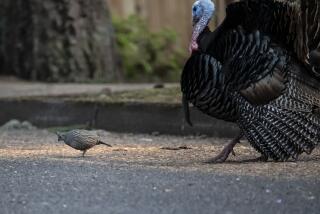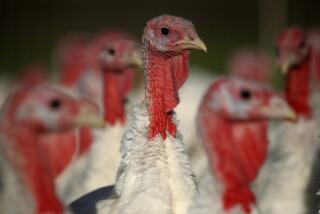ENVIRONMENT : Wild Turkeys Prove They’re Smart: Just Check Their Numbers
- Share via
DUE WEST, S.C. — Ray King was traveling a state highway not too far from this small town in western South Carolina recently when he was forced to stop abruptly.
There, strutting across the road with all the majesty of a prince at his coronation, was a wild turkey about the size of a small child.
“I eased up a little bit so I could watch him disappear into the woods,” said King, a professor at Erskine Theological Seminary here. “And what struck me is that old fellow’s got dignity. It was almost as if he knew he was in charge of that spot and even this massive piece of metal wouldn’t quicken his pace. Fascinating.”
Many people have found similar fascinations in recent years with the wild turkey, a species that just 50 years ago faced extinction in the United States, but now thrives in every state but Alaska. About 3.5 million wild turkeys live in the nation now, up from 30,000 in the early 1940s. It is one of the most remarkable comebacks in the history of wildlife conservation, biologists say.
Wild turkeys even exist in states outside their ancestral range, like California and Hawaii. Texas, with about half a million turkeys, has the most; Delaware, with 600, the least. California, which had 500 wild turkeys in 1952, now has about 100,000 birds.
“Growing up in northern Mississippi in the 1960s, turkeys were so rare. If you saw one or two, you considered yourself very fortunate,” said the Rev. Bill Letchworth, pastor of Rock Bridge Presbyterian Church near Clinton, S.C. “But just a few weeks ago, I saw 14 while I was deer hunting out here behind the house.”
Wild turkeys are so plentiful that they’ve been seen proudly perched on a car in a suburban parking lot in the Northeast and feeding beside a South Carolina college athletic field. They live in the Powder Valley Nature Center, a 112-acre refuge encircled by suburban St. Louis, and feed from back-yard bird feeders in the Midwest. And, in the surest sign of their restoration, turkeys are hunted in each state they reside.
“Deer and wild turkeys are the real success stories in wildlife restoration,” said Larry Vangilder, a wildlife research biologist for the Missouri Department of Conservation.
Missouri’s 25-year restoration effort, completed in 1979, parlayed a flock of 2,500 wild turkeys in the Ozarks into 350,000 birds all over the state.
Individual states, through their wildlife agencies, run their own programs, most of which began in the 1940s and 1950s and continue in all but a few states today, said Mary Kennamer, the spokeswoman for the National Wild Turkey Federation in Edgefield, S.C.
Much of the restoration was paid for by hunters through hunting license fees and contributions to organizations such as the Wild Turkey Federation, founded in 1973 to study and protect the birds that Benjamin Franklin once said would make the best choice for a national bird.
The wild turkeys’ downfall began in the early part of this century with the rapid development and timber harvesting on its prime stomping grounds. Unrestricted hunting further reduced the population.
Not to be confused with their distant and stupid cousin, the domesticated turkey commonly found in freezers, wild turkeys are highly intelligent and unpredictable. They can fly as fast as 55 m.p.h., run up to 20 m.p.h. and have keen eyesight. Biologists also say wild turkeys can distinguish alarming sounds and warn each other of threats. All of which makes the wild turkey a difficult quarry.
“I almost flunked out of college trying to hunt a bird I started calling ‘Old Boss,’ ” Letchworth said. “That turkey outfoxed me every time. He acted almost like he could reason.”
The turkey’s admirers now even include Texas Gov. Ann Richards, an experienced hunter of other game who brought down a bird Sunday with two shots from a 12-gauge shotgun.
The governor said listening to a caller imitate a hen, hearing the gobbler answer, then anticipating the bird as it approaches is as exciting as “waiting for your birthday.”
More to Read
Sign up for Essential California
The most important California stories and recommendations in your inbox every morning.
You may occasionally receive promotional content from the Los Angeles Times.










